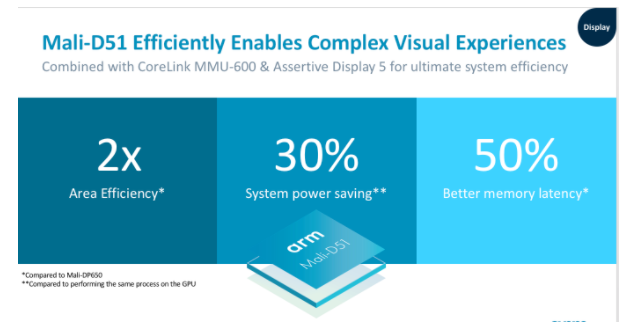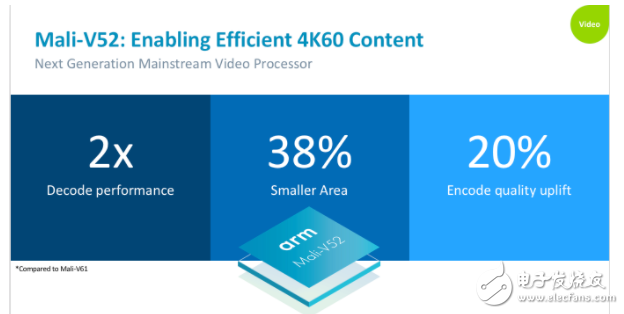The state of the art of cutting-edge technology is never static. New requirements such as complex visual content, continuously superimposed UI layers, and 4K HDR video are emerging. All of them are driving us to constantly break through the technical bottlenecks of mainstream mobile devices and achieve higher goals. Because of this, for the digital TV (DTV) and mainstream mobile markets, Arm has launched a new Mali multimedia kit that includes two image processors, one of which is a display processor and the other is a video processor.
Graphics complexity is mainly in the field of GPU processing, and in responding to the challenges of these emerging technologies, video and display processors play an important role, and they provide users with a truly high-quality visual experience.
The requirements for the display are getting higher and higher
Before, when we discussed GPU, we already talked about digital TV, but from the display point of view, today's generations of smart TVs have far exceeded expectations. In the past, when we were watching the show, the pop-up text-only menu was likely to cover the entire screen, very single. Today it is very different. Through a large number of pre-integrated applications, digital TV can provide different types, different levels of complexity and different viewing options, not to mention voice or gesture recognition user interface. As a result, the challenge to the display processor becomes very huge. In addition to the user's demand for picture-in-picture, there are even unique needs we have observed from the Chinese market. For example, users want to be able to see up to 16 video streams simultaneously in a 4x4 video wall. These demands pushed Arm to a new level once again.
Mali-D51 is Arm's first Mali display processor designed for the mainstream market based on the Komeda architecture. The Komeda architecture was released last year with the previous generation of high-end display processor Mali-D71. Compared with Mali-D71, Mali-D51 is 30% smaller in size and is designed to provide a high-quality visual experience on a smaller silicon area. In mainstream mobile devices, users are unlikely to need to play a lot of 4K content (which still belongs to the high-end performance field), but users still need the device to have the ability to play 4K content. Therefore, in the mainstream market, all we need to do is to make a wise choice, which may include reducing the size of the video stream from 4K to meet the user's display resolution requirements. Mali-D51 uses this advantage to display resolutions up to 2048x4096 pixels at 60fps and supports Mali-D71's 8-layer data processing capability.
Compared with the previous generation of mainstream product Mali-DP650 performing dual display, Mali-D51 achieves twice the scene complexity in the same area. When driving a single display, it uses the underutilized resources of the auxiliary display to add a second set of four composite layers to the scene. In addition, these composite layers can also be rotated, alpha blended or scaled, thus achieving twice the layer data processing capacity of Mali-DP650, which means that we can support UI overlays without GPUs. All additional data required for picture-in-picture etc.
Accessing memory is a common requirement in display technology. Therefore, compared with the previous generation, Mali-D51 has doubled the memory latency performance. With CoreLink MMU-600, Mali-D51 can achieve greater performance gain in the entire system. To drive pixels continuously to the display panel, the processor needs to periodically access the system bus, and doubling the memory latency performance of the processor means that it takes only half the time on the bus to drive the image to the panel. This speeds up the entire display thread and greatly improves the robustness of the system to prevent underruns, thereby providing seamless, real-time performance and avoiding any visual failure or human factors affecting the user ’s visual experience.

Value-added video experience
Arm's new video processor Mali-V52 is also designed to meet the growing demands of the mainstream market. The previous generation Mali-V61 was designed to achieve maximum scalability and meet all device requirements from the smallest and lowest power surveillance cameras to the latest top-level smartphones. Relative to the previous generation's feature of supporting a wide range of use cases, Mali-V52 is more targeted and specifically invested in the specific efficiency bonus of the mainstream market.
The scalability of Mali-V52 is 1-4 cores (Mali-V61 is 1-8 cores), which is specially designed for playing 4K content streams on mainstream devices with limited silicon area, so it is better than the equivalent performance The required size of Mali-V61 has been reduced by almost 40%. Obviously, this can save manufacturers a huge budget. It should be emphasized that, like Mali-D51, this new video processor has been greatly optimized through a series of intelligent trade-offs, providing a broad combination and choice for all of our partners. For entry-level devices, we have doubled the decoding performance of each core, which means that within the same silicon area, the chip can perform 4k60 decoding or 4k30 encoding. Using a single core of Mali-V61, the system can decode 1080p60; and a single core of Mali-V52 can support 4k30 or 1080p120 decoding. For mainstream video standards such as HEVC, H.264 and VP9, ​​the single-core decoding design performance Double that of the previous generation.
Mali-V52 is designed to ensure that the overall system cost and power consumption are optimized. For example, it can support longer system bus response time without degrading any performance. Equipped with Mali-V52, it can ensure that there is no frame loss within 400 cycles of fixed delay on the bus, which is twice the performance of Mali-V61. In addition, we have invested a lot of energy to ensure that the chip's memory access delay is up to 5000 cycles with recovery capability, so that the video processor can work offline in many clock cycles, giving way to including display processing The higher priority master device including the device.
Mali-V52 can also reduce the bit rate by 20% while maintaining the same quality as before, which has a significant effect on saving storage space and can achieve the highest quality within the same bandwidth. When we pay more for expanding the storage space of the device, this performance improvement will have a significant impact on the end user's use of video functions. Users can select specific quality levels and weigh them based on storage and power consumption priorities, which explains why it is particularly important to have a dedicated video processor in a mobile device instead of letting an overloaded CPU complete all tasks .
Like many emerging technologies, a use case driven by the Chinese market: just providing simple picture-in-picture is no longer enough to meet the needs of users. They want to be able to preview the programs they will watch, and Chinese users hope to Up to 16 continuously updated streaming media channels to choose the program you want to watch. This requirement to present a 4x4 video wall comes from many of our set-top box and digital TV partners in China, and has clearly become a basic requirement in the future, not a icing on the cake. We must develop a series of IP to solve this problem.

As a result, a single processor will retreat to the second line, and a full set of Mali multimedia kit will begin to appear.
Collaboration makes the world a better place
Compared with independent products, combining two or more Mali multimedia suite processors can significantly improve work efficiency. Arm supports a complete software stack to enable the hardware writer function on the display, allowing Android to view the hardware functions of the system and infer that it can send content to the display processor instead of the GPU-the stack can discover hardware and The software interacts with it automatically, and engineers do n’t even need to think about hardware.
As for the video wall use cases discussed above, Mali-V52 can decode 16 high-definition videos simultaneously and write them as a single frame to the display processor. With an excellent storage interface, Mali-D51 can extract the single frame and send it directly to the panel without any additional bottlenecks or jams.
For the entire system, the actual gain brought by the Mali multimedia suite processor is that it greatly saves the GPU load. If you want to perform tasks such as rotation, scaling, and gamma correction on the GPU, system power consumption will increase by more than 30%, which is a major problem constraining mobile devices. Although this does not prevent users from enjoying 4K content, the advantage of the Mali Multimedia IP Suite is that the new video processor Mali-V52 can directly shrink 4K content before sending it to the display processor. This means that users can directly watch the new cool 4K programs released by Netflix, Amazon, etc. on all consumer electronic devices. Not only 4K, Mali-V52 supports 10bit HDR content, and through perfect cooperation with Mali-D51 and Assertive Display 5, it can achieve the best content display on any type of panel (either HDR or SDR).
From digital TVs to smartphones, regardless of the user's budget, the Mali multimedia graphics, video and display suites can work together better to provide users with the highest quality visual experience.

About Arm
As the core of the computing and interconnected revolution, Arm technology is changing the way people live and operate their businesses. From indispensable areas to invisible support, Arm's advanced energy-efficient processor design has been applied to more than 100 billion chips to safely provide support for electronic devices, covering a variety of applications from sensors to smartphones to supercomputing. Arm has more than 1,000 technology partners, including the world's most famous commercial and consumer brands. Arm is actively collaborating and expects to apply Arm innovation to all areas that require computing, including chips, networks and clouds.
Vertical Mount Power D-SUB Connectors
ANTENK launches series vertical board mount Power-D & Combo-D D-SUB connectors machined contacts.
The ANTENK Power-D & Combo-D mixed contact d-sub connectors straight are designed for rugged / robust applications where both power & signal are required from a single connection. Featuring [Solid-Pin" machined contacts, these connectors offer high reliability performance for the most challenging design applications.
vertical board mount Power-D & Combo-D D-SUB connectors machined contacts applications
The ANTENK vertical mount combo d-sub, mixed contact connector product range is ideal for a multitude of both IP rated and non-rated industry applications. This diverse combo d-sub standard product offering includes up to 13 contact configurations (seen below) engineered for both power & coaxial connector environments such as satellite & weather stations, GPS receivers, transceivers and radio technology applications. Contact us directly for any custom or semi-custom combo d-sub connector project not listed in our standard product offering above.
Features of Vertical Mount D-SUB Connector Machined Contacts
Available in 12 industry standard sizes / positions.
Contact Antenk for other sizes / contact configurations.
Available in 10/20/30/40 amp power contacts, 5 amp signal
Allows signal, high current & high voltage in one connector.
Contacts are pre-loaded into the insulator.
Material of Vertical Mount D-SUB Connector Machined Contacts
Shell: Steel, Nickel plated
Insulator: Glass-Filled Thermoplastic, U.L. 94V-O, Black
Signal Contacts: Machined Copper Alloy, Full Gold Flash
Power Contacts: Machined Copper Alloy, Full Gold Flash
Male High Density Power D Mixed Contact Connectors, Female High Density Power D Mixed Contact Connectors, Male Standard Vertical Mount Power D-SUB Connector, Female Standard Vertical Mount Power D-SUB Connector
ShenZhen Antenk Electronics Co,Ltd , https://www.antenkconn.com